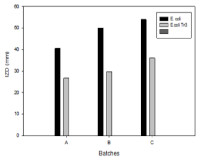Chitosan-based nanoparticles sustenance and potentiation of the antibacterial effect of ampicillin against drug resistance among strains of Escherichia coli
Main Article Content
Abstract
The study seeks to evaluate nanoparticles based on chitosan for enhanced delivery of ampicillin in plasmid-mediated drug resistance. Serial dilutions of a mixed population of E. coli was plated on nutrient agar and streaked on Replica-plate 25 random colonies using MacConkey agar with or without ampicillin (100 µg/ml) daily for 96 h. Nanoparticles were prepared by cross-linking chitosan with sodium tripolyphosphate with ampicillin trihydrate adsorbed. Three different batches were prepared for optimization. The nanoparticles were optimized based on encapsulation efficiency, in vitro drug release, pH stability and microbiological assay using two laboratory strains of E. coli. Increased resistance to ampicillin due to possible plasmid transfer was established in vitro after 96 h. The encapsulation efficiency of the three batches was between 21-57 %. The drug release showed a burst effect and slow extended release over 8 h and reached a peak of about 19 % release at the 6 and 7 h in Batch A, B and The pH of the particles was stable over a period of 6 d. The nanoparticles containing only 0.075 mg of ampicillin dropped in an agar well plate inoculated with 1 ml of E. coli J62 lac pro trp hispFlac::Tn3 (AmpR) gave an IZD of ≥ 25 mm. Chitosan nanoparticles holds good potentials in potentiating the antibacterial effect of ampicillin against possible plasmid-mediated drug resistance.
Downloads
Article Details

This work is licensed under a Creative Commons Attribution-NonCommercial-NoDerivatives 4.0 International License.
References
Bangun, H., Tandiono, S. and Arianto, A. (2018). Preparation and evaluation of chitosantripolyphosphate nanoparticles suspension as an antibacterial agent. J Appl. Pharm. Sci.8(12): 147-156.
Ciro, Y., Rojas, J., Onate-Garzon, J and Salamanca, C.H. (2019). Synthesis, characterisation and biological evaluation of ampicillin–chitosan–
polyanion nanoparticles produced by ionic gelation and polyelectrolyte complexation assisted by high-intensity sonication. Polym. 11(11):1758
Colom, J., Batista, D., Baig A., Tang Y., Liu S. et al. (2019). Sex pilus specific bacteriophage to drive bacterial population towards antibiotic sensitivity. Sci Rep. 9: 12616.
Goy, R.C., de Britto, D. and Assis, O.B.G. (2009). A review of the antimicrobial activity of chitosan. Polimeros. 19(3).
Khan, M.S., Sridhar, B.K. and Srinatha, A. (2010). Development and evaluation of pH- dependent micro beads for colon targeting. Indian J Pharm. Sci. 72(1): 18-23.
Kong, M., GuangChen, X., Xing, K. and JinPark, H. (2010). Antimicrobial properties of chitosan and mode of action: A state of the art review. Int. J Food Micro. 144(1): 51-63.
Li, M., Liu, Q., Teng, Y., Qu, L., Xi, Y., Chen, S. and Duan, G. (2019). The resistance mechanism of Escherichia coli induced by ampicillin in laboratory. Infect Drug Resist. 12: 2853-2863.
Onuigbo, E.B., Onugwu, A., Nwocha, M., Odiase, A. and Attama, A.A. (2016). Preparation and in-vitro evaluation of amoxicillin encapsulated in alginatecoated chitosan microparticles. Trop J Pharm. Res. 15(1):2303-2309.
Pedroso-Santana, S and Fleitas-Salazar, N. (2020). Ionotropic gelation method in the synthesis of nanoparticles/microparticles for biomedical purposes. Polym. Int. 69(5): 443-447.
Porras-Gómez, M. Vega-Baudrit, J. and Núñez- Corrales, S. (2018). Ampicillinloaded chitosan nanoparticles for in-vitroantimicrobial screening on Escherichia coli. doi: 10.5772/intechopen.76034.
Prabaharan, M. and Mano, J.F. (2005). Chitosan-based particles as controlled drug delivery systems. Drug Del. 14:41-57.
Raafat, D. and Sahl, H. (2009). Chitosan and its antimicrobial potential – a critical literature survey. Microb. Biotechnol.2(2): 186-201.
Razak, F., Chyzna, V., Morris, N., Murphy, A. and Kennedy, J. (2017). An investigation into the effects of pH and material concentration on the
morphology of chitosan-alginate microspheres prepared using an ionic gelation technique. Int. J Adv. Sci. Res. Manag. 2(10): 2455-6378.
Saeed M.R., Dmour, I. and Taha, M.O. (2020). Stable chitosan-based nanoparticles using polyphosphoric acid or hexametaphosphate for tandem ionotropic/covalent crosslinking and subsequent investigation as novel vehicles for drug delivery. Front. Bioeng. Biotechnol.
https://doi.org/10.3389/fbioe.2020.00004
Saha, P, Goyal, A.K. and Rath, G. (2010). Formulation and evaluation of chitosanbased ampicillin trihydrate nanoparticles. Trop. J Pharm. Res. 9(5): 483-488.
Sihui Wu, S., Tao, Y., Zhang, H and Su, Z. (2011). Preparation and characterization of water-soluble chitosan microparticles loaded with insulin using the polyelectrolyte complexation method. J Nanomat. https://doi.org/10.1155/2011/404523.
Tilkan, M.G. and Özdemir, N. (2018). Investigation of the parameters affecting the release of flurbiprofen from chitosan microspheres. Braz. J Pharm. Sci. 53(4):e00242.
Umeyor, E. C., Kenechukwu, F.C., Ogbonna,J.D., Chime, A.S., Attama, A.A. (2012). Preparation of novel solid lipid microparticles loaded with gentamicin and its evaluation in vitro and in vivo. J Microencapsul. 29(3): 296-307.
Yongmei, X and Yumin, D. (2003). Effect of molecular structure of chitosan on protein delivery properties of chitosan nanoparticles. Int. J Pharm. 250: 215-226.


